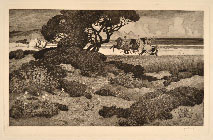Graudenz 1873 - Rome 1940
Sigmund Lipinsky grew up in the West Prussian Graudenz. In 1887 the family moved to Berlin, where Sigmund Lipinsky graduated from high school in 1888 and then studied at the Royal Academy of Arts. In 1899 Lipinsky undertook a trip to the Netherlands, where he added his knowledge in the field of graphic techniques. In the same year he won the competition for the design of frescoes for the castle of the family of Moltke in Kreisau in Silesia and received the state prize with Rome scholarship. In 1902 Lipinsky moved his residence from Berlin to Rome and settled down at Villa Strohl-Fern. He was able to finance an extension of the stay, as an artist of Jewish origin, through the award of the Michael Beer Foundation in 1904, and decided to stay in Rome in 1905. Here he joined the local German artists' association. Inspired by Otto Greiner, with whom he was a friend, and Max Klinger Lipinsky sought motifs in mythology and turned to symbolism. From 1911 Lipinsky devoted himself mainly to printmaking and founded the Sigmund Lipinsky Academy, a painting and drawing school, located in Via Margutta no. 33. The stay in Rome was interrupted by the First World War, and Lipinsky was compelled, like all German artists, to leave Italy. The family Lipinsky moved to Munich. Here he came into contact with the artists of the Munich New Secession, the Neue Künstlervereinigung and the Berlin New Secession. In 1919, the family returned to Rome and Lipinsky attended the drawing lessons at the British Academy of Arts. In his own academy for painting, graphics and drawing, he had numerous classes. With the Gruppo Romano Incisori Artisti - GRIA Lipinsky was represented at numerous exhibitions in Italy, Vienna and Berlin. Sigmund Lipinsky died in Rome in February 1940, where he was buried in the cemetery of Campo Verano. His works are in public collections in Rome, Florence, Monaco, London, Berlin, New York, Los Angeles, Warsaw and Graudenz.
